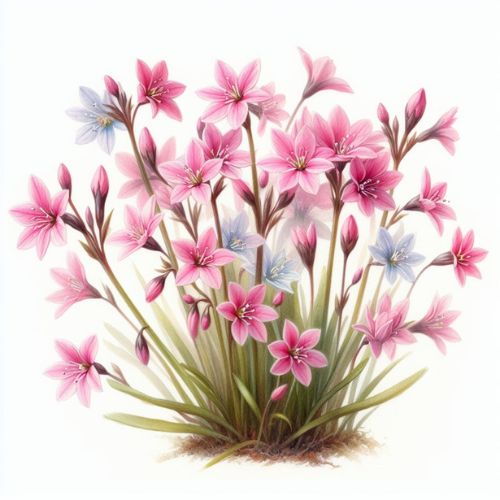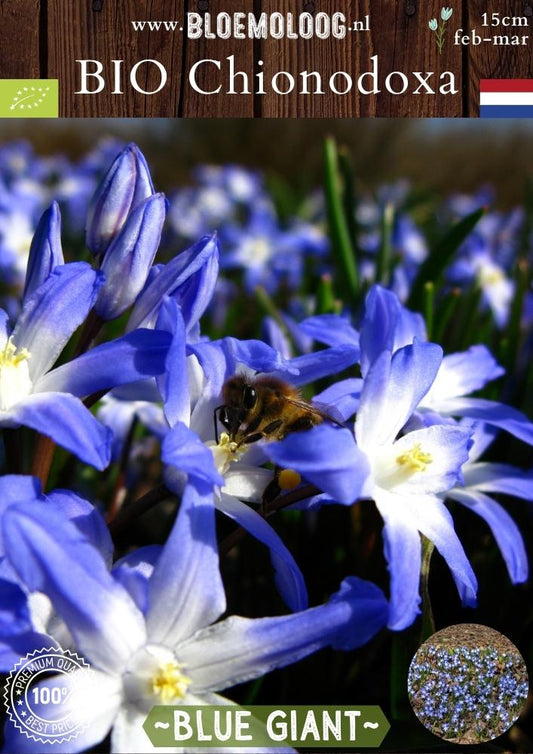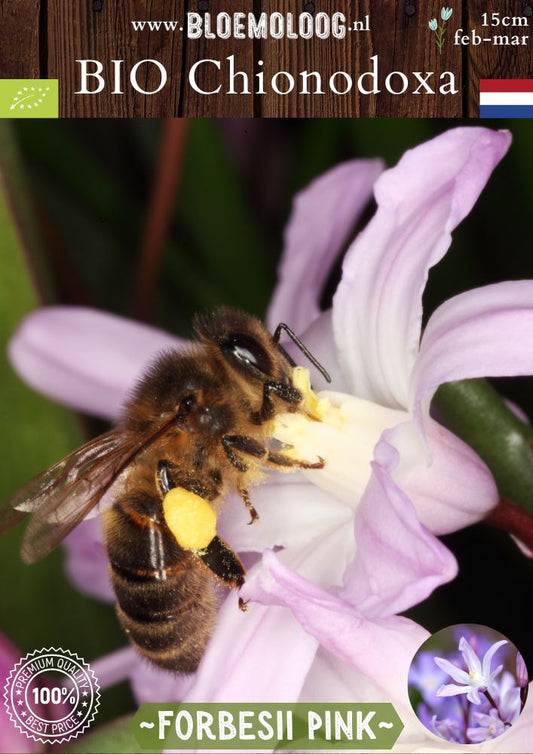
Collection: Organic Glory of the Snow
Organically grown Glory of the Snow flower bulbs
The Chionodoxa (syn. Scilla forbesii) is a special appearance, just after the cold winter, in early spring! It is also called 'glory of the snow' and is very popular because it blooms so early. This way bees have nectar early in the year so that they become extra strong for the summer.
The flower bulb of the Glory of the snow forms 2-3 trough-shaped leaves and grows to about 15 centimetres high. Per stem it gets 3 to 12 small white flowers with blue-coloured tips of about 5-7 centimetres wide. Characteristic of the 'large Glory-of-the-snow' is that the six tepals grow together in a tubular form at the base and in the middle of the flower the filaments are close together which forms a kind of tube-like covering around the ovary, whereby the anthers touch each other.
The difference between Chionodoxa, Puschkinia (tube hyacinth) and Scilla (Siberian squill) is that in Scilla the filaments spread outwards, while in Puschkinia the corolla consists of connected filaments that form the tube.
Oak processionary caterpillar
Tip: It is one of the types of flower bulbs that we recommend to take if you are bothered by oak processionary caterpillars. It attracts natural enemies of processionary caterpillars such as ichneumons. They lay eggs in the caterpillars that do not survive.
How, where and when do I plant Glory of the Snow bulbs?
A flower bulb of the 'Glory of the Snow' needs a cold period in the winter, so it is planted in the ground from September to January. It can be planted in any fertile garden soil, preferably in a nutritious, water-permeable, chalky sandy soil. Plant it in the sun or partial shade.
Plant them in groups in the grass, border, under trees or shrubs, in pots or even in a rockery. They are suitable for naturalisation in the right location. They come back faithfully every year.
When planting, the tip goes up and the old root crown goes down. The planting depth is 2 to 3 times the height of the flower bulb itself and the planting distance is 2 to 3 times the bulb width.
Caring for Glory of the Snow
Glory of the snow is a stinzenplant that naturalizes well. You plant it once and it will come back every year in the right location. Give it annual organic food for the best result. It needs little attention otherwise.
Propagating Glory of the Snow
Chionodoxa reproduces via brood bulbs and via seeds.
For propagation, the bulbs are taken out of the ground in June or July, remove the small brood bulbs and then dry the flower bulbs. The flower bulbs are best stored in a warm place out of the sun in the summer, for example in a shed and from September together with the small brood bulbs that the flower bulb produced the year before planted in the ground again.
Origin of the Glory of the Snow
The Chionodoxa is native to western Turkey, but has been running wild in Dutch gardens for centuries. It comes from the asparagus family (Asparagaceae) and Scilloideae is its subfamily. 'Glory of the Snow' is the literal translation of Chionodoxa, which comes from the Greek word 'chiōn' which means 'snow' and 'doxa' which means 'glory'.
Buy organic Glory of the Snow
It is of great importance that the flower bulbs of the Chionodoxa, because of the attraction to bees, are grown without chemical crop protection agents. At the Bloemoloog you can only get organically grown flower bulbs of the glory of the snow.
When to buy Chionodoxa?
From June to January, Glory of the Snow flower bulbs can be ordered from the Bloemoloog. These are available from August to January at the market to pick out yourself.
-
Organic Chionodoxa forbesii 'Blue Giant' - Glory of the Snow | 10 pcs.
Regular price €4,95Regular priceUnit price €0,50 each -
Organic Chionodoxa forbesii 'Pink Giant' - Pink Glory of the Snow | 10 pcs.
Regular price €4,95Regular priceUnit price €0,50 each
-
Organic spring bulbs
Spring-flowering bulbs and tubers are popular plants that produce beautiful flowers from early spring through summer. Because of their early bloom, they combine well with perennials when they still need to establish themselves.
Tulips are probably the most well-known spring flowers. They come in many different colors, shapes, and sizes. Daffodils are known for their cheerful yellow flowers, but they also come in other colors like white and orange. Crocuses are small bulbous plants with striking flowers in shades of purple, yellow, and white. They are often the first flowers to appear in spring. Hyacinths have fragrant flowers in various colors, such as pink, purple, blue, and white. They are often planted in borders, flower beds, or pots.Benefits of organic spring bulbs
When you choose organic flower bulbs that bloom in spring, you can be sure that no chemicals or pesticides will end up in your garden. These pesticides are harmful to bees and prevent them from finding their nests. As a result, more and more bee species have been added to the red list in recent years. Together, we can do something about this!
Flower bulbs for wild bees
Did you know that wild bees lay eggs in their nests, which then hatch in early spring? These newborn insect helpers immediately search for food in the surrounding area. There are also insects that have hibernated and are desperately looking for a hearty breakfast: the blooming flowers where nectar and pollen can be found! Just after winter, there's little greenery or food for these insects. Planting early-blooming flower bulbs ensures there's food available, and the insects can gain strength for the coming summer.
Organic growers
The organic growers we work with cultivate not only the most beautiful but also the strongest products. They cultivate varieties and species of flowers and plants that experience has shown to be virus-resistant, so they don't need to use chemicals and pesticides. Organic growers seek natural remedies and solutions against diseases and/or pests. All our flower bulbs are certified organic; both the Florist and the growers are SKAL-certified.
When do you plant spring bulbs?
Spring-flowering bulbs can be planted from autumn until January. Bulbs that need to be dug up in the summer after flowering should be dug up starting in late July and stored until the next planting season in autumn.
What to do after flowering
When spring bloomers have finished blooming, cut off the wilted flowers at the top of the stem. Let the rest of the plant die back naturally so it can still receive maximum energy from the sun.
How do you store spring bulbs?
If you've purchased flower bulbs from us and had them delivered to your home and would like to leave them for a while, we recommend opening the box and storing it in a ventilated, cool place until you're ready to plant them.
Store flower bulbs you dig up after flowering in a warm place, such as a shed. To prevent mice from eating the bulbs during this period, you can also hang them in a bag or pantyhose. -
Where is the best place to plant spring bulbs?
Spring-flowering bulbs are flowers that bloom in the spring, between January and July. There are many different types of spring-flowering bulbs, suitable for different types of gardens and soil. For example, some bulb plants enjoy catching a glimpse of the sun during flowering, but prefer to be covered by a tree during their dormant period in summer.
Spring bloomers in the sun
Many spring bloomers need plenty of sun to bloom and grow well for the following year. These flowers thrive in full sun:
Spring bloomers in the shade
Some spring bloomers also grow and bloom well in the shade, such as:
Spring bloomers in moist soil types
There are also flower bulbs that can be planted in moist soil. Some varieties from the Florist's collection include:
Conclusion
There are many different types of spring bloomers suitable for different types of gardens and soil. Whether a spring bloomer can grow in sun or shade depends on the specific variety. Some prefer dry soil, while others prefer wet feet. So, there's a suitable spring bloomer for every garden.
Tips for a flowery garden
Plant a variety of flowers, each with its own blooming time, so there are flowers blooming throughout the spring and food for bees and other insects in your garden. Would you also like to arrange your garden/bed so you can enjoy flowers all spring long, and the bees too? Feel free to send us a message or ask us at the market stall. We're happy to help! Promote biodiversity in your garden and enjoy the first flowers and colors after the cold and dark winter!
Order spring bloomers in advance
Pre-sales for spring-flowering bulbs will begin on June 1st in the Bloemoloog webshop.
During the pre-sale, you can pre-order your desired products. This way, you can be sure your favorite flowers are still in stock, and we'll ship your package with PostNL as soon as planting time arrives.
Flower bulbs ordered in the pre-sale will be delivered in mid-September. From then on, they can be planted directly in the garden or in containers on the balcony.




